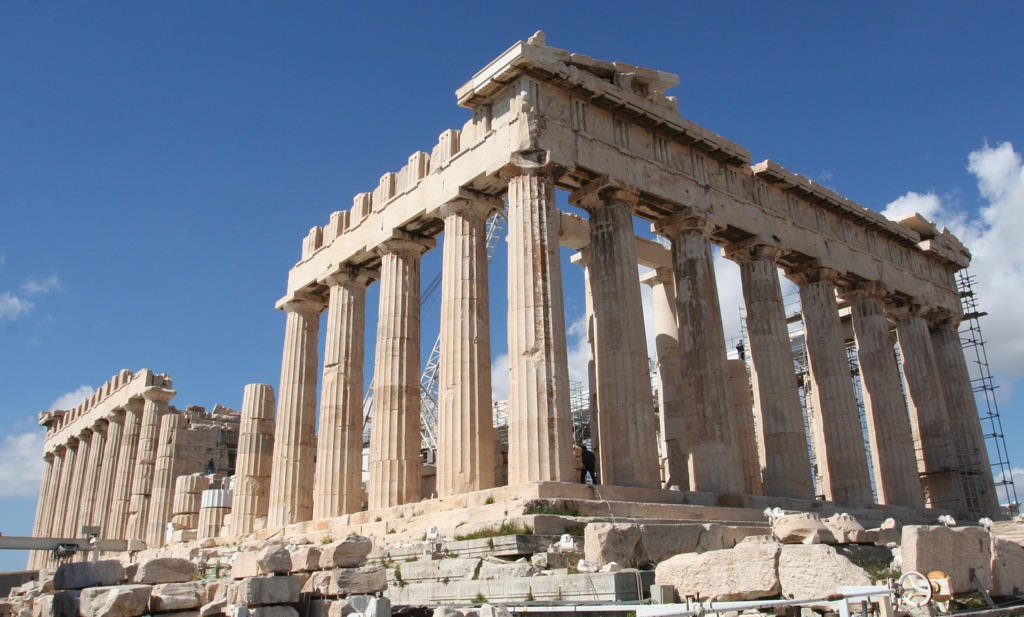The Parthenon stands as a symbol of Ancient Greek civilization and is one of the most recognizable monuments in the world. Located on the Athenian Acropolis, it was a temple dedicated to the goddess Athena, whom the people of Athens considered their patron. Constructed during the 5th century BCE, it is the culmination of the Doric order of architecture, though it also includes Ionic architectural features. The Parthenon has endured for nearly 2,500 years, surviving wars, explosions, and earthquakes. Today, it is a UNESCO World Heritage Site and a treasured ruin that continues to be studied and preserved.
Get your dose of History via Email
Historical Background of the Parthenon
The Parthenon’s discovery wasn’t like unearthing a hidden treasure; it has always been visible, dominating the Athens skyline. Its construction began in 447 BCE during the golden age of Athenian democracy under the leadership of Pericles. The architects Iktinos and Kallikrates, along with the sculptor Phidias, designed the temple. The Parthenon replaced an earlier temple that Persians destroyed in 480 BCE during their invasion of Greece.
Throughout history, the Parthenon has served multiple roles. After its time as a temple, it became a treasury and later a church dedicated to the Virgin Mary during the Byzantine era. When the Ottoman Empire took control, it was converted into a mosque in the early 1460s. The structure suffered significant damage in 1687 when an Ottoman ammunition dump inside the building was ignited by Venetian bombardment.
Lord Elgin removed some of the Parthenon’s surviving sculptures in the early 19th century, which are now housed in the British Museum. This act sparked ongoing debates about cultural heritage and the repatriation of artifacts. The Greek government has made several requests for the return of the sculptures, known as the Elgin Marbles, to Athens.
The Parthenon has been the scene of historical importance, not only due to its architectural grandeur but also because of its role in the development of Western civilization. It has inspired countless buildings worldwide and remains a symbol of artistic and democratic excellence.
Excavations and restorations of the Parthenon have been ongoing since the 19th century. These efforts aim to preserve the monument for future generations and to provide insights into its construction and use. The Greek Ministry of Culture and the Acropolis Restoration Service oversee these projects, ensuring that the work adheres to the highest standards of archaeological practice.
About the Parthenon
The Parthenon is a masterpiece of the Doric order, though it includes Ionic elements such as the frieze. It was built using Pentelic marble, which was transported from the nearby Mount Pentelicus. The structure’s design incorporates complex optical illusions; for example, none of the columns are perfectly straight, but they appear so to the human eye.
The Parthenon’s dimensions are monumental, measuring approximately 70 meters in length and 31 meters in width. Its eight columns at the façade and seventeen on the flanks were engineered to withstand the test of time. The architects designed the Parthenon to house a colossal statue of Athena Parthenos, made of gold and ivory, which stood inside the main chamber, or cella.
Architectural highlights include the metopes, which depict scenes from Greek mythology and history, and the pediments, which once showcased intricate sculptures representing the birth of Athena and her contest with Poseidon. The frieze, running around the upper edge of the cella wall, illustrates the Panathenaic procession, a festival in honor of Athena.
The construction methods of the Parthenon were advanced for their time. Workers used precise calculations and levering techniques to fit the massive marble blocks together without mortar. They also employed detailed relief work and carving to create the decorative elements that adorn the structure.
Despite the damage it has sustained over the centuries, the Parthenon remains a testament to the architectural skill of the ancient Greeks. Its enduring beauty and precision continue to captivate scholars and tourists alike.
Theories and Interpretations
Several theories about the Parthenon’s purpose and design have been proposed over time. Originally, it served as a temple to Athena and a symbol of Athenian power. Some scholars suggest that the building also functioned as an astronomical observatory, as certain architectural alignments correspond to celestial events.
The Parthenon’s sculptures and friezes have been subject to various interpretations. Some view them as a representation of Athenian democracy, showcasing the city’s citizens in a religious procession. Others interpret the scenes as mythological, reflecting the gods’ favor towards Athens.
Mysteries surrounding the Parthenon include the precise use of the smaller chamber within the cella, known as the Parthenon’s treasury. Some historians believe it held offerings to Athena, while others speculate it contained the city’s reserves of gold and silver.
Matching the Parthenon to historical records has been a challenge due to the lack of contemporary accounts. However, inscriptions on the stones have provided valuable information about the people who built it and the financial aspects of its construction.
Dating the Parthenon has been carried out using historical records and archaeological evidence. The consensus is that the main phase of construction occurred between 447 and 432 BCE. Modern techniques, such as thermoluminescence dating of the ceramics found on the Acropolis, support this timeframe.
At a glance
Country: Greece
Civilization: Ancient Greece
Age: Constructed between 447 and 432 BCE
Conclusion and Sources
Reputable sources used in the creation of this article include:
- Wikipedia: https://en.wikipedia.org/wiki/Parthenon
- Encyclopedia Britannica: https://www.britannica.com/topic/Parthenon
- World History Encyclopedia: https://www.worldhistory.org/Parthenon/
- The Acropolis Museum: http://www.theacropolismuseum.gr/en
- UNESCO World Heritage Centre: https://whc.unesco.org/en/list/404

